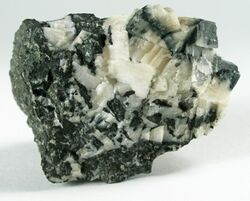Chemistry:Berzelianite
| Berzelianite | |
|---|---|
 Berzelianite included in calcite from the Skrikerum mine in Sweden. | |
| General | |
| Category | Selenide minerals |
| Formula (repeating unit) | Cu2Se |
| Strunz classification | 2.BA.20 |
| Dana classification | 2.4.10.1 |
| Crystal system | Isometric |
| Identification | |
| Color | Silvery white, tarnishes easily |
| Crystal habit | Dendritic crusts, fine-grained inclusions |
| Cleavage | None |
| Fracture | Uneven |
| Tenacity | Slightly malleable |
| Mohs scale hardness | 2.7 |
| |re|er}} | Metallic |
| Streak | Shining |
| Diaphaneity | Opaque |
| Density | 6.71 (measured) 7.28 (calculated) |
| Ultraviolet fluorescence | None |
| Common impurities | Ag |
| References | [1][2][3] |
Berzelianite is a rare copper selenide mineral with the formula Cu2Se.[2][3][4] It occurs as thin dendritic crusts or as fine-grained inclusions. It crystallizes in the isometric system,[5][6][7] unlike its dimorph, bellidoite, which crystallizes in the tetragonal system.[8] The crystals are opaque and slightly malleable.
Occurrence and name
Berzelianite was first identified at the Skrikerum Mine (also spelled as Skrickerum Mine) in Valdemarsvik, Östergötland, Sweden in 1850.[6]
It was named by James Dwight Dana to honor Jöns Jakob Berzelius, a Swedish chemist who is seen as the father of analytical chemistry. He invented chemical symbol notation and discovered the elements cerium, selenium, silicon, and thorium.[6]
Berzelianite often occurs together with eucairite, clausthalite, tiemannite, umangite, klockmannite, aguilarite, crookesite, athabascaite, stromeyerite, polybasite, pearceite, gold, uraninite, pyrite, marcasite, calcite.
See also
References
- ↑ Warr, L.N. (2021). "IMA–CNMNC approved mineral symbols". Mineralogical Magazine 85 (3): 291–320. doi:10.1180/mgm.2021.43. Bibcode: 2021MinM...85..291W. https://www.cambridge.org/core/journals/mineralogical-magazine/article/imacnmnc-approved-mineral-symbols/62311F45ED37831D78603C6E6B25EE0A.
- ↑ I.Y. Nekrasov (1 January 1996). Geochemistry, Mineralogy and Genesis of Gold Deposits. CRC Press. p. 238. ISBN 978-90-5410-723-1. https://books.google.com/books?id=HUWRZecignoC&pg=PA238.
- ↑ Stephen B. Castor; Gregory C. Ferdock (2004). Minerals of Nevada. University of Nevada Press. p. 163. ISBN 978-0-87417-540-0. https://books.google.com/books?id=flAhr0MbxM8C&pg=PA163.[yes|permanent dead link|dead link}}]
- ↑ Bernhard Pracejus (25 June 2015). The Ore Minerals Under the Microscope: An Optical Guide. Elsevier Science. p. 202. ISBN 978-0-444-62737-7. https://books.google.com/books?id=nkibBwAAQBAJ&pg=PA202.
- ↑ "Handbook of mineralogy Berzelianite". http://www.handbookofmineralogy.org/pdfs/berzelianite.pdf.
- ↑ 6.0 6.1 6.2 "Berzelianite: Berzelianite mineral information and data.". http://www.mindat.org/min-645.html.
- ↑ Barthelmy, Dave. "Berzelianite Mineral Data". http://www.webmineral.com/data/Berzelianite.shtml#.WAzdXOh9600.
- ↑ "Bellidoite: Bellidoite mineral information and data.". http://www.mindat.org/min-611.html.
 |
